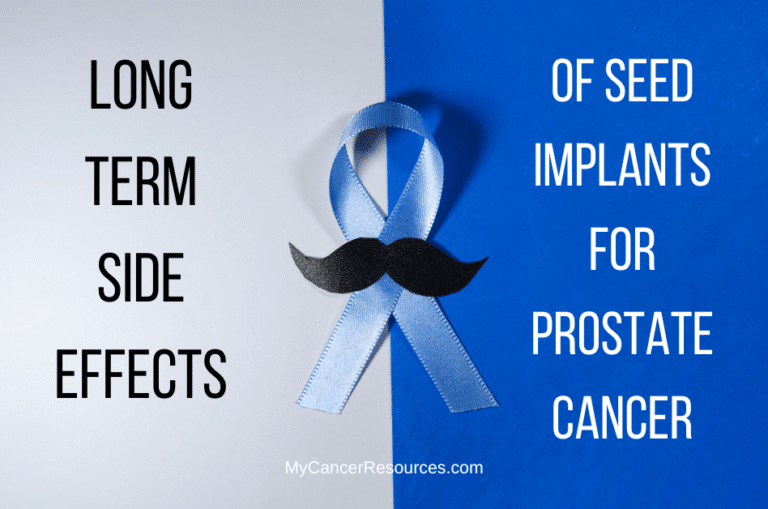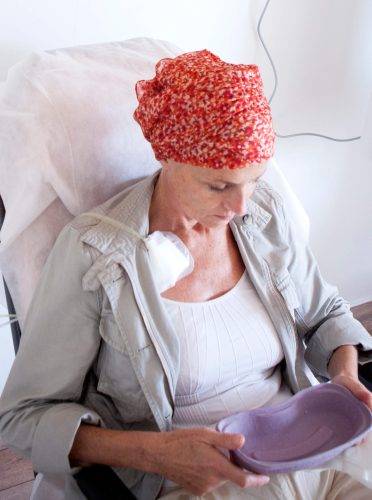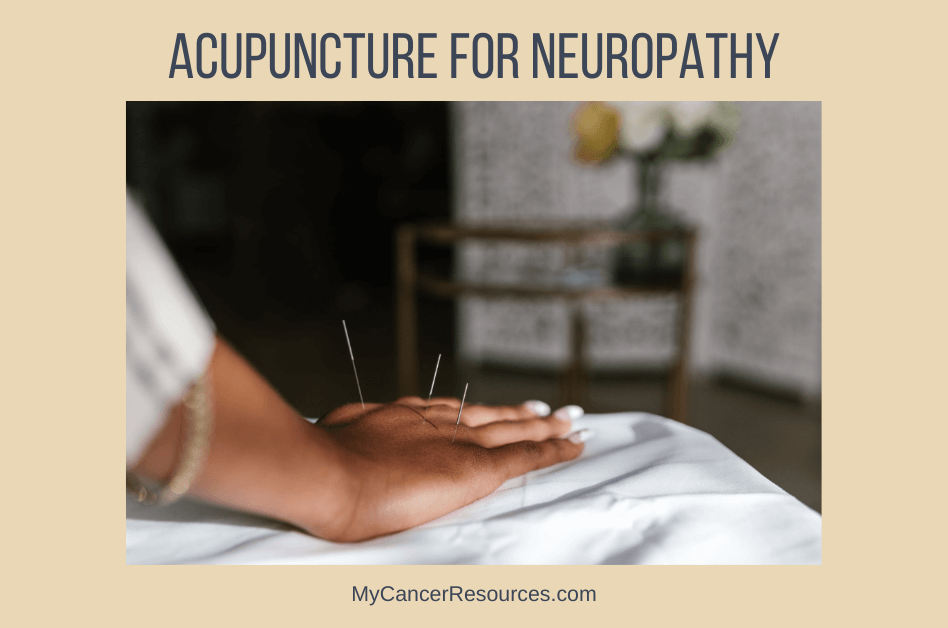
You or a loved one may be dealing with a diagnosis of prostate cancer, and one of the treatment options that’s been presented might be brachytherapy, which is also called seed implants. It’s natural (and good!) to have questions about the treatment, what it involves, and what the long-term side effects of seed implants for prostate cancer are.
This post will serve as a high-level overview of the seed implant procedure and what to expect in both the short and long term.
Many of my clients hear about it from their doctor and the nursing staff, but in that moment, it’s easy to be overwhelmed and not catch everything that’s been said about a treatment plan. My clients appreciate that I can take however much time is needed to answer their questions, summarize the latest research and help them identify the pros and cons so they can make the decision on which treatment plan is best for them.
An Introduction to Seed Implants for Prostate Cancer
Seed implants are a type of radiation therapy that involves placing small radioactive seeds, about the size of a grain of rice, directly into the prostate gland.
These seeds emit radiation that targets and kills cancer cells, with the intention of causing minimal damage to surrounding healthy tissue.
The targeted approach is the procedure’s main appeal. Compared to other treatment options, it’s less invasive or dramatic, but still effective.
By focusing the radiation dose inside the prostate gland, the risk of damage to nearby organs is reduced.
Your healthcare team may have also referred to this procedure as low-dose rate brachytherapy, where the emission of radiation is at a slower pace over a period of weeks or months.
While seed implantation can be very effective in treating early-stage prostate cancer, it’s important for you to understand the possible long-term side effects of seed implants for prostate cancer and how they can affect your health and mental wellbeing.
Understanding Prostate Cancer Treatment Options
There are different options for you to consider as treatments for prostate cancer. The plans recommended to you by your medical team may vary depending on the the stage of cancer, your scores on other tests used to evaluate the extent of the disease, your age and overall health.
If prostate cancer was found in very early stages, a strategy of what’s called “active surveillance” could be recommended. This is a ‘watch and see’ approach where there’s no treatment given right away, and instead the healthcare providers closely monitor your lab work to determine if the cancer has progressed.
If your doctor doesn’t want to use surveillance, or if the cancer progresses or is diagnosed at a later stage, you’ll likely be presented with other treatment options to consider.
There are two types of prostate brachytherapy:
- Low-dose rate (LDR): this involves implanting radioactive seeds in the prostate gland permanently. They slowly release radiation over the course of several months.
- High-dose rate (HDR): HDR is a temporary implantation. Radioactive sources are implanted into the prostate gland and a high dose of radiation is given. After a short time, the seeds are removed. HDR treatment may need to be repeated several times.
Low dose rate is the procedure that’s also called seed implants, so that’s what I’ll be focusing on in this article.
Another option is called a radical prostatectomy, which is the complete surgical removal of the prostate gland.
Another option is external beam radiation therapy (EBRT). With EBRT, radiation is delivered from outside the body, and targeted to the general region of the prostate.
Hormone therapy might go along with your radiation treatment, depending on factors like PSA levels and Gleason scores. Hormones can shrink the prostate and cancer cells, making radiation more effective.
Seed Implants vs. Other Therapies
Seed implantation, also known as brachytherapy, is a form of radiation therapy that is very different from other treatments like external beam radiation therapy and radical prostatectomy.
In brachytherapy, radioactive seeds, each about the size of a grain of rice, are placed directly into the prostate gland. These seeds deliver radiation to the cancer cells with the aim of killing the cancer cells off.
The radiation is confined largely within the prostate gland itself, which minimizes damage to nearby healthy tissues. This targeted approach often brings about fewer side effects compared to external beam radiotherapy.
External beam radiation therapy involves a radiation dose administered from outside the body, targeting the prostate. Although this is also an effective treatment, it can impact a broader area, which can lead to a greater chance of developing unwanted side effects.
A radical prostatectomy, which involves surgical removal of the prostate gland, completely eliminates the gland but comes with its own set of potential complications. Urinary incontinence and erectile dysfunction can be very common for those undergoing this procedure.
Brachytherapy could be done alone or in combination with external radiation or hormone therapy, depending on your PSA level, Gleason score, and tumor stage. Your radiation oncologist will evaluate your unique situation to recommend which method would be best for you.
Seed Implantation Procedure
Let’s walk through the procedure of implanting seeds, so that you can get a better idea of the reasons for short and long-term side effects of seed implants for prostate cancer.
Seed implantation is an outpatient procedure. The procedure itself lasts about an hour, but you’ll have things to do to prep for the procedure and afterwards you’ll need to be observed, so you’ll be at the hospital for a number of hours.
In the operating room you’ll likely be placed under general anesthesia so you aren’t awake during the procedure and don’t feel pain.
A trained specialist will guide an ultrasound probe into your rectum, revealing your prostate on a screen to make it easy to see where to place the permanent implant.
A small needle is then inserted through your skin in your perineum, the area between your scrotum and your anus, and into your prostate. There, a number of small radioactive seeds will be placed into the prostate.
These seeds will emit radiation over weeks or months, taking the fight directly to cancer cells, minimizing damage to healthy tissue around your prostate.
After the procedure is over, you’ll be moved to a recovery area for observation, and then you’ll go home.
You’ll need to take it easy and avoid heavy lifting for a while. You may be told to limit close contact with small children, pregnant individuals, or those trying to become pregnant in order to prevent them from being exposed to radiation.
You may also be told to wear a condom during sex to protect your partner. These should all just be short-term precautions, until your radiation levels in your body decrease over time.
You’ll return to the clinic at regularly scheduled intervals so your doctors can continue to monitor your PSA level to make sure the treatment is working.
Common Side Effects: Urinary and Bowel Symptoms
Some of the most common side effects of seed implants for prostate cancer have to do with the urinary tract and the bowels. This makes sense, due to the location of the prostate and the effects of radiation in that area.
Changes in bladder function are pretty common immediately after seed implantation. Issues like frequent urination or urinary incontinence can be a daily challenge in the first few months after the procedure.
A number of patients report these side effects are worse in the first six months or so, but often improve over time. Some, however, experience urine leakage and urine retention as a long term side effect.
Bowel symptoms and patterns also change after a prostate brachytherapy procedure. You may experience pain, increased frequency, feelings of urgency, loose stools, rectal irritation or bleeding.
Studies have shown these tend to get better within the first year after the procedure. Some however, experience bowel complications over the long term.
As irritating as these symptoms might be, remember that they’re a typical response your body might have to the radioactive seed implants.
Each individual’s experience to the side effects of brachytherapy can vary depending on factors like overall health, the number of seeds implanted, and the dose of radiation that’s administered.
If you’re dealing with persistent urinary or bowel problems, talk to your healthcare provider. Specialists can offer tailored solutions or prescribe medications that can relieve your symptoms.
In some cases, additional therapies may be needed to restore urinary and bowel function to a comfortable level.
Managing Urinary Problems
You’ll need to address urinary issues right away to help you maintain your quality of life post-treatment. Begin by tracking your symptoms and scheduling a consultation with your healthcare provider.
To alleviate mild incontinence, pelvic floor exercises, known as Kegel exercises, can strengthen the muscles that control urination. Your doctor might also suggest medications that relax bladder muscles and improve urinary control.
If you’re dealing with urinary retention, catheterization may be necessary, but it’s typically a short-term solution. For more persistent cases, surgical options exist to relieve obstruction or repair damage caused by radiation.
Keep a journal of your fluid intake and urinary output. This record can reveal patterns and help you anticipate the need for bathroom breaks, reducing accidents. Stay vigilant about hydration as well, since concentrated urine can irritate your bladder and make symptoms worse.
If you’re struggling with nocturia, which is the need to urinate frequently throughout the night, limit fluids before bedtime to help you sleep longer between waking to use the bathroom.
Remember that consistent follow-up with your medical team is crucial. They can monitor your progress and adjust your treatment plan to manage any lingering urinary issues.
Taming Bowel Issues
Here are some strategies for dealing with bowel changes:
- Consult your doctor: If you face ongoing issues or observe blood in your stools, reach out to your doctor. They may prescribe medications to regulate bowel movements or suggest increasing your fiber intake.
- Stay hydrated: Drink plenty of fluids to protect against dehydration, especially if diarrhea is a concern. Water, herbal teas, and electrolyte solutions can help maintain your body’s balance.
- Maintain a balanced diet: Eat a healthy diet that includes a variety of foods. Talk to a dietitian if you’re unsure of the best choices for your situation. They can tailor advice to your specific needs, potentially recommending foods that can help firm up your stools or reduce irritation.
- Monitor your symptoms: Keep a diary of your bowel movements, noting frequency, consistency, and any accompanying pain. This record could really help your healthcare team track your progress and adjust your treatment as needed.
- Exercise regularly: Gentle physical activity can improve your digestion and reduce the risk of constipation. Even a daily walk can make a significant difference in how you feel.
- Explore pelvic floor exercises: Strengthening exercises for the pelvic floor muscles may reduce incontinence and help you gain better control over bowel movements.
Remember, while bowel issues can be embarrassing and uncomfortable, they are also manageable. Your doctor and support team are there to assist, so don’t hesitate to seek their guidance to navigate through this challenge.
Sexual Health Post-Implantation
Probably the most common and most distressing complaint of prostate cancer treatment adverse effects are the changes in sexual function. Erectile dysfunction is a potential short and long-term side effect.
You may experience difficulty achieving or maintaining an erection, and these challenges could affect both intimacy with your partner and your quality of life.
Not all hope is lost, though if you’re facing these issues. There are treatment options that can help in managing sexual dysfunction, like medications, vacuum erection devices or penile implants. It may take a while to find the right solution for you, so speak openly with your medical provider about what you’re experiencing.
One of the most important things you can do if you’re experiencing sexual side effects is to communicate openly and honestly with your partner. They can provide emotional support and you can work together to maintain intimacy that doesn’t require intercourse.
A therapist with experience in sexual health for people with cancer and their partner can really help by providing strategies to cope with these adjustments.
The Risk of Secondary Cancers
A small percentage may develop bladder cancer or lower bowel cancer after radiation for prostate cancer. This includes those who have received permanent brachytherapy. This is rare, but can occur many years after treatment.
Your oncology team will make sure you have regular screenings to check for any new signs of cancer. Be sure to attend these appointments, even if you feel fine.
If you notice some new symptoms or other health concerns in between appointments, reach out to your healthcare team. You want to be able to catch any new or worsening cancer early to increase the number of treatment options you have.
Lifestyle Considerations and Limitations
You might need to adjust certain lifestyle habits to manage the long-term side effects of seed implants for prostate cancer.
Intense physical activities, such as heavy lifting, require caution. Your physician will likely advise you to avoid strenuous tasks shortly after the seed implant procedure to prevent dislodging the radioactive seeds.
In addition, sexual activity can often resume based on your comfort and readiness, but discuss any concerns with your doctor to ensure safe sexual practices.
Urinary symptoms, like frequent urination or urgency, might change social habits and travel planning. Work proactively to scout out restroom locations if you go out and consider wearing protective pads in order to navigate these changes with confidence.
Diet can influence bowel and urinary symptoms, so consider consulting a dietitian to tailor food choices that can help relieve issues like diarrhea or constipation.
Remember, you play an important role in your recovery and maintaining a good quality of life post-treatment. Balance rest with activity, seek support when necessary, and stay informed about your health to keep your quality of life as high as possible.
Support Systems and Coping Strategies
After treatment for prostate cancer, you’ll need both medical attention and emotional support. Remember that you are not alone.
Your doctor may refer you to a specialist clinic, where professionals with lots of experience with prostate cancer survivors will understand your challenges and offer solutions tailored to your unique situation. They may suggest lifestyle changes, exercises, or medication to help ease the side effects.
Support groups can also play a significant role in your life post-treatment. Sharing experiences with others who’ve walked a similar path can be incredibly affirming, reducing the isolation often felt during recovery. These communities can also offer practical advice and coping strategies that have worked for others.
Don’t underestimate the importance of family and friends. They can offer day-to-day help and emotional support. Keep open lines of communication with them about what you’re experiencing, as it enables them to understand better how they can help you.
Professional counseling with a therapist or an experienced holistic cancer coach should also be considered, particularly if you struggle to cope. They can provide coping mechanisms, addressing not just the physical but the emotional and psychological facets of your recovery.
Physical activity is also really helpful. Engaging in regular exercise that’s appropriate for your condition can stimulate overall well-being, improve mood, and improve a variety of physical functions.
Acknowledge the uniqueness of your situation and remember that managing side effects is an ongoing process. Seek the tools and support you need, and take this journey one step at a time.
Advancements in Minimizing Side Effects
Over the years, big strides have been made in radiation oncology to lessen the long-term side effects of seed implants for prostate cancer. This innovative technique precisely targets cancer cells while saving healthy tissue and minimizing damage that can lead to long-term issues. These advancements include:
- Advancements in Imaging: Enhanced imaging technologies, such as multiparametric MRI, are now used to map the prostate gland more accurately. This allows for better placement of the radioactive seeds, reducing the amount of radiation exposure to surrounding organs.
- Improved Seed Technology: The design of seed implants has improved along with the radioactive material used, resulting in more consistent and controlled radiation dose rates.
- Personalized Treatment Plans: Doctors now use a patient’s unique characteristics—like prostate size, Gleason score, and PSA level—to craft individualized treatment regimens. This includes calculating the number and strength of seeds implanted, to provide just the right amount of radiation necessary.
- Combination Therapies: For some patients, LDR brachytherapy can be combined with external beam radiation therapy or hormone therapy to use a lower overall radiation dose. This can effectively treat cancer while resulting in fewer side effects.
- Focus on Quality of Life: Current research is not just about improving survival rates but also about enhancing the quality of life post-treatment. This includes monitoring and addressing potential urinary, bowel, and sexual dysfunction issues from the beginning, using preventative strategies, and offering rehabilitative services soon after treatment.
Ongoing clinical trials and studies continue to refine these methods, with the goal of delivering safer and more effective treatments.
Looking Ahead: Life After Seed Implant Therapy
After you’ve received seed implant therapy for prostate cancer, you step into a new phase of life. This period demands patience as your body adjusts to changes post-treatment.
One important aspect to monitor is your PSA (prostate-specific antigen) level, which should decrease and level off, which indicates the treatment has been successful. Regular follow-up appointments with your healthcare provider are crucial to catch and address any issues early.
Even as you resume normal activities, you may need to modify certain habits. For instance, heavy lifting could strain the pelvic region and should be avoided for a while. Pay attention to your body and report any ongoing urinary or bowel symptoms, which might need medical intervention. Sexual health concerns, such as erectile dysfunction, are common and can be managed with the guidance of a specialist.
Your daily routine may include preventive measures against the rare but possible development of secondary cancers. This includes leading a healthy lifestyle and possibly undergoing additional screening.
You might find solace and strength in support groups and resources designed for those who’ve undergone similar experiences.
Embrace a positive mindset as you navigate life after seed implant therapy, maintaining open communication with family, friends, and your medical team to build a strong support system.
Finally, stay informed about new advancements in prostate cancer care, as research continually discovers better techniques to minimize side effects and improve quality of life.
If you are looking for support and guidance as you navigate life after a prostate cancer diagnosis, reach out to me – I’d be happy to help both you and/or your caregiver.



